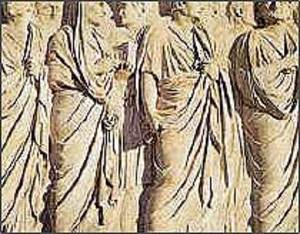Gaius Julius Caesar Octavian Augustus Germanicus Caligula – yes that’s all one person, and you’ve probably more than one time in your life seen one of these monstrously sized Roman names and asked yourself, “What exactly does it mean?” In the United States and most of Western Culture we have three basic names that are more or less easy to understand. We have a first name – this is what everyone calls us, this is what we’re recognized as among family, friends, and the work place. Most of us have a middle name, which acts as a parent’s “second shot” in case the first name didn’t come out as well in practice as it sounded in their heads. Then we have a surname, or last name, which links us to our family. We share this with everyone in our family (unless the mother chooses to keep her maiden name or any other special circumstances). It identifies as a part of a specific cluster of people linked through blood or adoption.
Romans had something of a similar naming layout – though humorously with maybe a quarter of the total available names.
First and foremost you will see a praenomen – this is fundamentally like our first names, but still not quite. All other names involved in the naming were legally obligatory, leaving parents with only control over deciding the praenomen. Nevertheless, it was still heavily shared (being from the small pool of names that it was) between family members. Take for example Publius Cornelius Scipio – his father was Publius Cornelius Scipio, and his elder brother? You guessed it, Publius Cornelius Scipio.
Curiously in a study called the Corpus Inscriptionum Latinarum, a study of Latin engravings, it was found that the seventeen most popular praenomen constituted 98% of the used praenomen.
Generally speaking this praenomen was not heavily used, to the point that it was relegated to little more than an abbreviation on official documents. Likewise it was considered rude to refer to someone in a formal situation by their praenomen, as this was a name otherwise intended to be spoken between friends and family. It would be akin to calling the President of the United States in the middle of a Press Conference “Bobby” or “Timmy”, using both the insult of using the person’s first name directly and a nickname meant privately for use in the home.
Amusingly, in the early Roman Republic, praenomens were chosen to correspond with numerical coincidences with the child’s birth. For example a child born in December may likely see their name become Decimus – same for a child born tenth into the family. This practice fell out of favor as Rome’s population expanded and names were simply more liked for their sound rather than their numerical significance.
Next in the Roman naming standard came the gens – sometimes referred to as the Noman gentile. The rules for this naming was hardcoded into Roman Law and was unalterable at birth. The gens is intended to assign the individual to a “family clan”, referred to as the gens. Now that is not to say that two people from the same gens were committed incest necessarily – in fact it was encouraged, in the early years of the Roman Republic, for people to marry inside of the same gens. It’s rather like assigning a single overarching name to everyone from California for tax collection and political affiliation purposes – they are linked as a community but not through blood.
So using Publius Cornelius Scipio as another example, while his praenomen was Publius he was of the Cornelius gens. No one knows the origins of the Cornelii exactly, but it’s very possible (and likely) that they are of Etruscan origin. Therefore the Etruscan family or political group that was initially inducted under this name would pass it on to all political associates thereafter.
Finally in typical Roman naming there was the cognomen. Not until 100 B.C. was this considered an official part of the name – indeed legal documents did not even recognize or use the cognomen until then. It was something of a nickname assigned to an individual that was usually inherited by his son. After 100 B.C. however this became an important part of Roman naming, as it separated families inside of a gens. For example, the Caesars (meaning hairy) were one particular family of the Julii gens (also known as a House). There were many other Julii who were not necessarily related to Gaius Julius Caesar, but they shared a noman gentile.
Therefore it’s important to understand that while Caesar is indeed Gaius Julius Caesar’s family name, he was recognized rather as a part of the Julii Clan more than he was recognized as a Caesarian – that is until the Civil War. Afterwards Caesar became synonymous with King or Emperor.
In the case of Publius Cornelius Scipio, however, this was expanded on a little. The Scipiones were a particularly famous family inside of the Cornelii – having made a remarkable claim for themselves during the Punic Wars. While one is usually politically associated with their gens family, in the case of the Scipiones, they held such remarkable political clout themselves that they were their own faction on the Senate.
So in review, the basic Roman had three names: the praenomen, the noman gentile or gens nomina, and the cognomen – the praenomen being the first and informal name, the noman gentile being the clan name, and the cognomen being a specific family name inside of that branch. In the follow up article, female names agnomen will be explained in detail.




